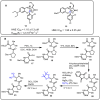Boron Chemicals in Drug Discovery and Development: Synthesis and Medicinal Perspective
- PMID: 35565972
- PMCID: PMC9104566
- DOI: 10.3390/molecules27092615
Boron Chemicals in Drug Discovery and Development: Synthesis and Medicinal Perspective
Abstract
A standard goal of medicinal chemists has been to discover efficient and potent drug candidates with specific enzyme-inhibitor abilities. In this regard, boron-based bioactive compounds have provided amphiphilic properties to facilitate interaction with protein targets. Indeed, the spectrum of boron-based entities as drug candidates against many diseases has grown tremendously since the first clinically tested boron-based drug, Velcade. In this review, we collectively represent the current boron-containing drug candidates, boron-containing retinoids, benzoxaboroles, aminoboronic acid, carboranes, and BODIPY, for the treatment of different human diseases.In addition, we also describe the synthesis, key structure-activity relationship, and associated biological activities, such as antimicrobial, antituberculosis, antitumor, antiparasitic, antiprotozoal, anti-inflammatory, antifolate, antidepressant, antiallergic, anesthetic, and anti-Alzheimer's agents, as well as proteasome and lipogenic inhibitors. This compilation could be very useful in the exploration of novel boron-derived compounds against different diseases, with promising efficacy and lesser side effects.
Keywords: ALS; aminoboronic acids; bezoxaboroles; boron-containing drugs; boron-containing retinoids; brain cancer; lipogenic inhibitors; proteasome inhibitors.
Conflict of interest statement
The authors declare no conflict of interest.
Figures









































Similar articles
-
The Rise of Boron-Containing Compounds: Advancements in Synthesis, Medicinal Chemistry, and Emerging Pharmacology.Chem Rev. 2024 Mar 13;124(5):2441-2511. doi: 10.1021/acs.chemrev.3c00663. Epub 2024 Feb 21. Chem Rev. 2024. PMID: 38382032 Review.
-
Boron chemicals in diagnosis and therapeutics.Future Med Chem. 2013 Apr;5(6):653-76. doi: 10.4155/fmc.13.38. Future Med Chem. 2013. PMID: 23617429 Free PMC article. Review.
-
Boron in drug design: Recent advances in the development of new therapeutic agents.Eur J Med Chem. 2019 Oct 1;179:791-804. doi: 10.1016/j.ejmech.2019.06.092. Epub 2019 Jul 3. Eur J Med Chem. 2019. PMID: 31288128 Review.
-
Boron-Based Drug Design.Chem Rec. 2015 Jun;15(3):616-35. doi: 10.1002/tcr.201402100. Epub 2015 Mar 20. Chem Rec. 2015. PMID: 25800654 Review.
-
Boron-Containing heterocycles as promising pharmacological agents.Bioorg Med Chem. 2022 Jun 1;63:116748. doi: 10.1016/j.bmc.2022.116748. Epub 2022 Apr 18. Bioorg Med Chem. 2022. PMID: 35453036 Review.
Cited by
-
Ultrathin Boron Growth onto Nanodiamond Surfaces via Electrophilic Boron Precursors.Nanomaterials (Basel). 2024 Jul 29;14(15):1274. doi: 10.3390/nano14151274. Nanomaterials (Basel). 2024. PMID: 39120380 Free PMC article.
-
Synthesis of Boron-Containing Nucleoside Analogs.J Org Chem. 2024 Feb 2;89(3):1556-1566. doi: 10.1021/acs.joc.3c02179. Epub 2024 Jan 16. J Org Chem. 2024. PMID: 38227951 Free PMC article.
-
Replacement of nitro function by free boronic acid in non-steroidal anti-androgens.RSC Med Chem. 2024 Sep 10;15(12):4018-38. doi: 10.1039/d4md00343h. Online ahead of print. RSC Med Chem. 2024. PMID: 39345716 Free PMC article.
-
The Mechanism of Boron-Carbon Bond Formation in the DA Reaction of the Pyridine Adduct of Borabenzene with Acetylene: A Topological Analysis of the ELF Function and Catastrophe Theory.Molecules. 2025 May 28;30(11):2357. doi: 10.3390/molecules30112357. Molecules. 2025. PMID: 40509242 Free PMC article.
-
The current utility and future potential of multiborylated alkanes.Nat Rev Chem. 2024 Oct;8(10):741-761. doi: 10.1038/s41570-024-00650-x. Epub 2024 Sep 26. Nat Rev Chem. 2024. PMID: 39327469 Review.
References
-
- Das B.C., Ojha D.P., Das S., Evans T. Boron-Based Compounds: Potential and Emerging Applications in Medicine. John Wiley & Sons; New York, NY, USA: 2018. Boron Compounds in Molecular Imaging; pp. 205–231.
Publication types
MeSH terms
Substances
Grants and funding
LinkOut - more resources
Full Text Sources
Other Literature Sources
Miscellaneous

